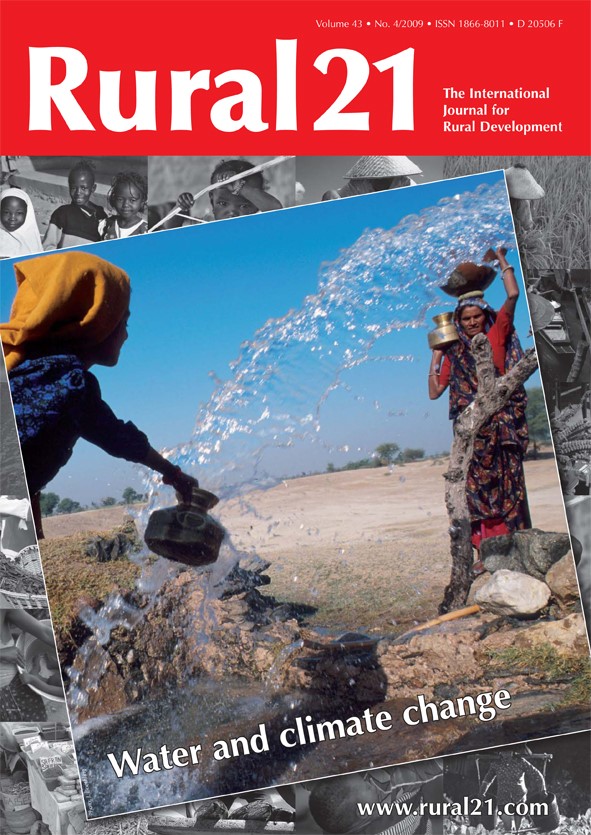Location
The international journal Rural 21 has dedicated more than 40 years to all topics surrounding rural development. Its ambition is to further those strategies and policies that strengthen rural areas of developing and newly industrialising countries and encourage their implementation. The journal addresses the complete range of relevant themes – from agriculture and fisheries via capacity building and education through to health and social security, energy supply and trade. Center-stage is always devoted to inquiring into how measures and strategies can contribute to global food security and to reducing poverty.
Rural 21 desires to further the dialogue between science and politics, the private sector, civil society and practitioners. Two platforms are designed for this purpose: Rural 21 in print is published four times a year, each issue highlighting a specific focus of rural development – this print edition is read in more than 150 countries. In parallel, Rural 21 online keeps the rural development community up to date on news and events, scientific findings and other print and online publications.
Rural 21 is published by DLG-Verlag GmbH in Frankfurt/Germany. Financial partners are BMZ (German Federal Ministry for Economic Cooperation and Development), GIZ (Deutsche Gesellschaft für Internationale Zusammenarbeit), DLG (German Agricultural Society – Deutsche Landwirtschaft-Gesellschaft), SDC (Swiss Agency for Development and Cooperation) and Helvetas Swiss Intercooperation.
The first issue of Rural 21 dates back to 1968. From 1974 to 2007, the journal was published in three languages entitled "entwicklung & ländlicher raum" / "agriculture & rural development" / "agriculture & développement rural". In 2008, the journal was relaunched as "Rural 21".
Members:
Resources
Displaying 246 - 250 of 319Impact of melting glaciers in the Himalaya
The Himalayan region is not only tectonically active and ecologically fragile but is it also one of the most economically underdeveloped and most densely populated mountain ecosystems on the planet. These natural as well as human characteristics render the Himalayan region highly vulnerable to the impacts of development, degradation and climate change and in particular the impact of melting of glaciers and changes in the patterns of precipitation.
How do small farmers respond to climate change in Rajasthan?
Water is scarce in India's semiarid zones of Rajasthan. Climate change is putting additional pressure on the rare resources. Irregular or no rainfall forces many small farmers to abandon their fields, at least temporarily, and seek work in the towns. Participative water management projects as practiced in Bhipur village, growing crops with low water requirements and more sustainable farming practices are adaptation strategies that allow farmers to continue their activities despite climate risks.
Integrated Watershed Management
Water and soils are increasingly becoming a limiting resource for meeting the food requirements
of a growing world population. Integrated concepts for managing natural resources in a sustainable
and environmentally sound manner show encouraging impacts, if applied on a large scale and
over a long period like in Tigray, the northernmost regional state of Ethiopia.
Development policy and security policy: An alliance with conflict (management) potential
In Germany, the debate about the security/development nexus is gathering pace. The reality of life in crisis regions, the management of post-conflict situations and the precautionary anticipation of demands arising in the context of crisis management all require the highest level of coordination at political and local level and on a cross-sectoral basis. Long-term improvement of this coordination, both vertical and horizontal, is the most important resource factor for these two policy areas and can be achieved without mobilising additional budget funds.
Kenya: thriving green crops with no economic impact
Kenya is still largely agrarian with 80 percent of its population depending on agriculture for food, employment and income. The dilemma facing the country is that only 20 percent of the land is suited for agricultural production. A greater proportion of the country, however, consists of agroecologically less favoured areas (LFAs). Another dilemma in Kenya?s agricultural sector is that economic development impacts are not homogeneously spread even among the agriculturally favoured areas.



